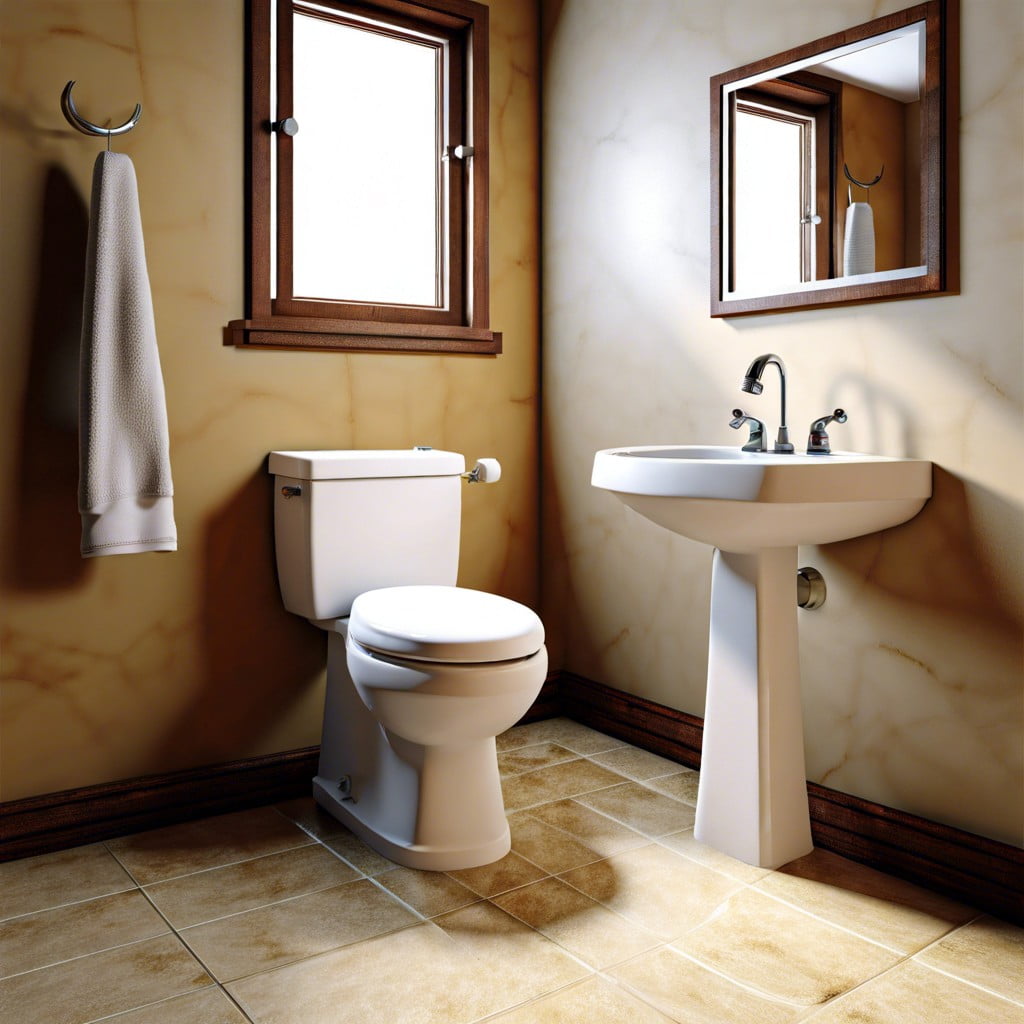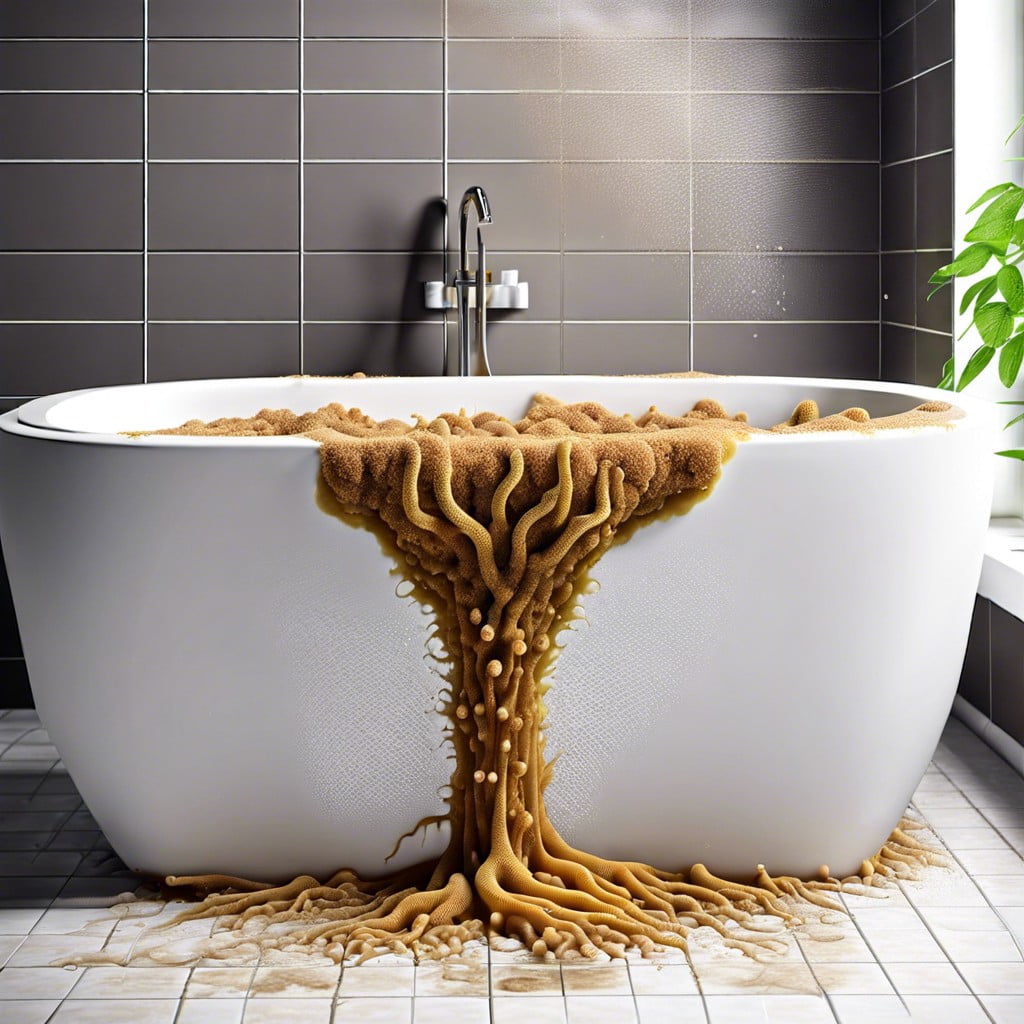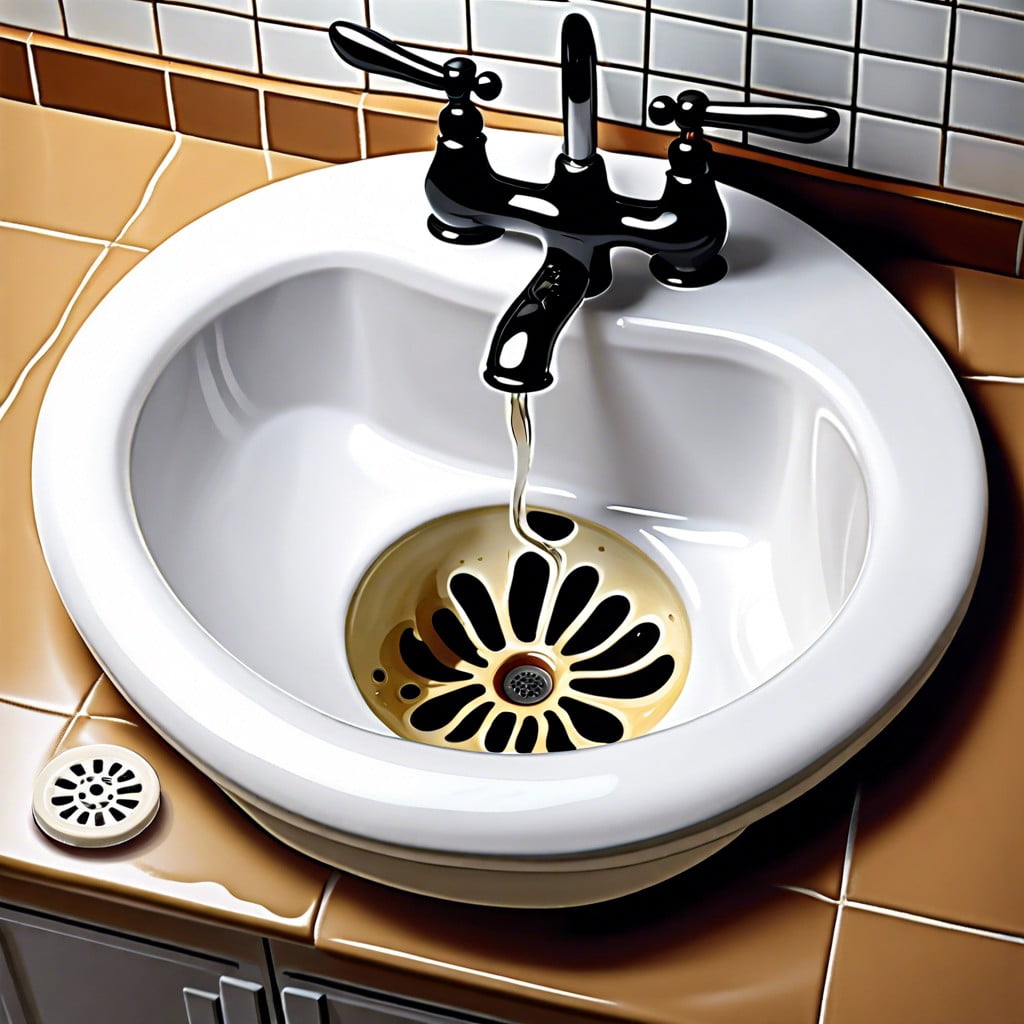Last updated on
Discover how to eradicate that stubborn sour smell from your bathroom because, in this guide, we’ve got foolproof tips and tricks that promise to leave it smelling fresh and clean.
Key takeaways:
- Identify the source of the sour smell in your bathroom
- Check for dry or dirty P-traps and clean or refill them
- Inspect for leaky pipes and address them promptly
- Remove biofilm buildup using natural cleaners or enzymatic drain cleaners
- Clear drain clogs using boiling water, baking soda, or vinegar
Identifying the Source of the Smell

Pinpointing the culprit behind an unpleasant odor requires a methodical approach. Start by sniffing around to localize the scent’s strongest concentration. Is it near the toilet, the sink, the shower drain, or permeating the entire room? Often, a specific fixture will be the source.
Once localized, inspect for visible signs of mold, leaks, or residue that could indicate where the smell originates.
Next, examine the P-trap—a U-shaped pipe beneath sinks and showers designed to hold water and prevent sewer gases from rising into the bathroom. If the water in the P-trap has evaporated, from infrequent use for example, it could allow sewer smells to seep in. Pouring water down infrequently used drains can quickly remedy this.
Also consider if the smell intensifies after a shower or flushing the toilet, as this can reveal issues with drainage or the seal around the base of the toilet. Each clue you uncover narrows down the possibilities, leading you closer to resolving the issue effectively.
Dry or Dirty P-Trap

The P-trap is a U-shaped pipe under your sink designed to hold a small amount of water, creating a seal that prevents sewer gases from entering the home. If this trap dries out, say from infrequent use or evaporation, the protective barrier no longer stops the sour smell. Alternatively, debris accumulation in the P-trap can cause odor.
To remedy a dry P-trap, simply run water in the sink for a minute. For cleaning, you can flush the drain with a mixture of hot water and vinegar or baking soda, which can both dislodge debris and neutralize odors. Remember, prevention is key: regular use and pouring water down infrequently used drains keep p-traps from drying out.
Leaky Pipes

Inspect your bathroom for any signs of moisture on walls, ceilings, or floors which could point to leaking pipes behind them. Mold or mildew, particularly in areas that should be dry, is another telltale sign of leaks.
Listen carefully – sounds of dripping or running water when no fixture is in use might indicate a problem. Check under the sink for wetness or water marks on the cabinet floor. Tightening fittings or applying plumber’s tape can sometimes provide a quick fix, but if you suspect a leaky pipe, it’s essential to address it swiftly to prevent potential water damage and the persistent sour odor.
For hidden leaks or more serious issues, enlisting a professional plumber is advisable. Regularly inspecting pipes for signs of wear can help catch leaks early, preventing the sour smell from taking hold in your bathroom.
Biofilm Buildup

Slippery to the touch and invisible on your shower curtain or drain edges, biofilm is a collection of microorganisms encased in a slimy matrix. While typically harmless, when excessive, it can emit a sour odor:
- Composed primarily of bacteria, biofilm thrives in moist environments—making bathrooms a perfect breeding ground.
- A combination of soap residue, body oils, and other organic material feeds this microbe community.
- Routine cleaning often misses these microbes, allowing them to multiply undisturbed.
- Natural cleaners like vinegar or baking soda can break down the biofilm without harsh chemicals.
- Regularly scrubbing shower curtains, sinks, and drains with a stiff brush can prevent buildup.
- For tougher cases, enzymatic drain cleaners specifically target biofilm and organic material.
Drain Clogs

Hair, soap residue, and other materials can accumulate in your drain, gradually leading to clogs. These blockages not only slow water drainage but also become breeding grounds for bacteria, emitting a foul, sour odor.
To address this, boiling water can sometimes clear away the gunk. If that doesn’t work, baking soda and vinegar are natural alternatives that can help dislodge blockages without the harshness of chemical cleaners.
For persistent issues, a plunger or plumber’s snake might be necessary to physically remove the obstruction.
Regular cleaning and the use of drain strainers can help prevent future clogs and associated smells.
Broken Shower Drain
A compromised shower drain can be a silent culprit, often unnoticed until the distinct sour scent begins to waft. Hair and soap scum can sneak into crevices, causing a minor crack to become a smelly issue over time. Moisture trapped in these fissures provides a perfect breeding ground for mold and mildew, which contribute to unpleasant odors.
Here’s what you should keep an eye on:
- Seals and Gaskets: Check the integrity of the seals. If they’re worn out or degraded, they could be allowing water to seep into places it shouldn’t.
- Physical Damage: Look for any visible signs of a break or crack in the drain assembly. Even small cracks can let in bacteria that cause odor.
- Water Flow: If water isn’t draining properly, it could be indicating that a break is obstructing the flow and needs to be addressed.
Take prompt action to investigate and repair any damage to prevent the smell from persisting or worsening. A silicone sealant or plumbing putty might be a temporary fix, but for lasting solutions, consider consulting with a professional plumber. Regular monitoring of the shower drain’s condition can help catch breaks early, avoiding more significant, smell-inducing issues.
Sewer Gas
Sewer gas often makes its way into bathrooms due to loose toilet seals or malfunctioning vent pipes. This unwelcome odor is a concoction of ammonia, methane, and hydrogen sulfide, which not only smells bad but can also be harmful at high concentrations.
To prevent this:
- Check the wax ring under your toilet. If it’s deteriorated, it could be the culprit.
- Inspect the toilet base for any signs of leakage.
- Vent pipes should be clear of obstructions to prevent gas from being trapped.
- Make sure all water seals are functioning, which involves checking that there’s water in the toilet bowl and floor drains.
- If you smell gas frequently and can’t identify the source, it may be from the sewer service line, which may require a plumber’s expertise.
Low Water Levels in the Toilet Trap
Ensuring that your toilet bowl maintains an adequate water level is crucial. This water serves as a barrier, preventing sewer gases from entering your bathroom.
However, if you notice the level is consistently low, it may signal a slow leak or an issue with the fill valve.
Check for cracks in the toilet bowl, as these can cause water to slowly seep out, reducing the protective water barrier.
Adjusting the fill valve to allow more water to enter the tank after each flush can also remedy this issue and restore the necessary water level in the toilet trap.
Regularly inspect the toilet bowl and tank to catch any potential leaks early on, maintaining a functional and odor-free bathroom.
Improper Bathroom Ventilation
Adequate airflow is crucial in preventing moisture buildup and eliminating odor-causing bacteria. Without proper ventilation, steam from hot showers can condense on walls and floors, creating an ideal environment for mildew and mold growth, which contribute to unpleasant smells.
Ensure your bathroom fan is clean from dust and operational, running it during and for 30 minutes after showers. Cracking a window or using a dehumidifier can also help regulate humidity levels and keep the air fresh.
Periodically check air vents for blockages and consider upgrading your fan if it seems inadequate for the size of your bathroom. Regularly airing out your space prevents stale air and maintains a fresh, odor-free environment.
DIY Sewer Smell Solutions
Before you call in the pros, there are several effective methods you can try to banish that pungent sewer smell:
1. Pouring Water: If a dry P-trap is the culprit, simply pour a gallon of water down the drain to refill the trap and block odors from rising up.
2. Baking Soda and Vinegar: Mix these two household items and pour them down the drain to neutralize and dissolve organic matter. Let sit for several hours before flushing with hot water to tackle biofilm or clogs.
3. Enzyme Cleaners: These cleaners are specifically designed to break down organic matter in the pipes. Follow instructions on the bottle for the best results.
4. Check the Toilet: Ensure water levels are adequate in the toilet bowl to maintain the water seal against gases.
5. Clean Overflow Holes: Using a small bottle brush, clean out sink overflow holes to prevent bacteria and mold growth.
6. Inspect Washing Machine Hoses: Make sure they are well-sealed and check for any evidence of leaks.
7. Check Ventilation: Clean the exhaust fans and make sure they work properly to remove moisture and odors efficiently.
By methodically trying these solutions, you can often solve the problem without the need for professional help.
When to Call a Professional Plumber
Despite your best efforts, if the sour smell persists or worsens, it’s time to consult a professional. Persistent odors may signal a deeper problem like a broken seal or a need for pipe repair – issues that DIY may not tackle effectively. Additionally, if you notice any water damage, mold, or if the smell accompanies a sluggish drain, these could be indicators of underlying plumbing issues. Plumbers are equipped with the tools and expertise to diagnose and resolve these complex situations safely and efficiently. Remember, addressing plumbing problems early can prevent more significant damage, saving time and money in the long run.
Regular Cleaning and Maintenance Tips
To prevent unpleasant odors from taking root in your bathroom, a proactive approach is key. Here are actionable tips to keep your space fresh:
1. Weekly Scrubbing: Commit to a weekly scrub of the sink, toilet, and shower to fend off biofilm and grime accumulation.
2. Flush Drains: Pour boiling water down the drains regularly to dislodge unseen clogs and maintain clear passageways.
3. P-Trap Primer: Run water in seldom-used sinks or showers to ensure the P-trap isn’t drying out, which can allow sewer gases to escape.
4. Ventilation Check: Inspect and clean exhaust fans semi-annually to ensure they’re functioning efficiently, pulling moisture and odors out of the bathroom.
5. Natural Solutions: Consider using vinegar or baking soda mixtures for a non-toxic cleaning alternative that neutralizes odors.
6. Toilet TLC: Check the toilet’s seal and water level periodically, as any issues here can cause odor.
7. Grout Care: Seal grout lines to prevent moisture and bacteria from accumulating and emitting a sour smell.
8. Routine Inspection: Look out for signs of leaking or damage near plumbing fixtures and address promptly.
By incorporating these practices into your cleaning routine, you’ll create a healthier, odor-free bathroom environment.
Ventilation Improvements
Enhancing your bathroom’s airflow can drastically reduce moisture and unwelcome odors. Consider installing an exhaust fan if you haven’t already, and make sure to use it during and at least 20 minutes after showers to expel humidity and odors.
Keep the bathroom door ajar when it’s not in use to promote air circulation. For natural ventilation, crack open a window when weather permits. Additionally, check your existing fan’s capacity; it might be time for an upgrade if it’s not powerful enough for the size of your bathroom.
Clear obstructions from vents regularly to ensure they’re not contributing to stagnant air. Incorporating these simple changes can make a significant difference in maintaining a fresh bathroom atmosphere.
FAQ
Why does my bathroom suddenly smell sour?
A sour smell in your bathroom could be due to issues like a damaged toilet seal, burst pipe, corroded sewer pipes, or rooting entered sewer lines.
How do you fix a sour smell in a drain?
To fix a sour smell in a drain, pour one cup of baking soda and one cup of vinegar down the drain, let it sit for ten minutes, then flush with boiling water followed by cold tap water.
Where is the smell in my bathroom coming from?
The unpleasant smell in your bathroom is likely originating from buildup of hair, soap scum, and other debris in your bathroom drains over time, creating a blockage or slowing the flow.
How do I get the sour smell out of my toilet?
To eliminate the sour smell from your toilet, combine equal parts of white vinegar and baking soda in the tank, scrub gently with a toilet brush, let it sit for a few hours, scrub again, and then flush.
What are effective natural ways to eliminate sour odors in a bathroom?
Effective natural ways to eliminate sour odors in a bathroom include using homemade air fresheners, adding potpourri, utilizing essential oils, baking soda, white vinegar, or lemons, and ensuring proper ventilation.
Could hidden mold be causing the sour smell in my bathroom?
Yes, hidden mold can potentially be the cause of a sour smell in your bathroom.
Can plumbing issues lead to a persistent sour smell in the bathroom?
Yes, plumbing issues such as sewer gas leaks can lead to a persistent sour smell in the bathroom.
Recap




